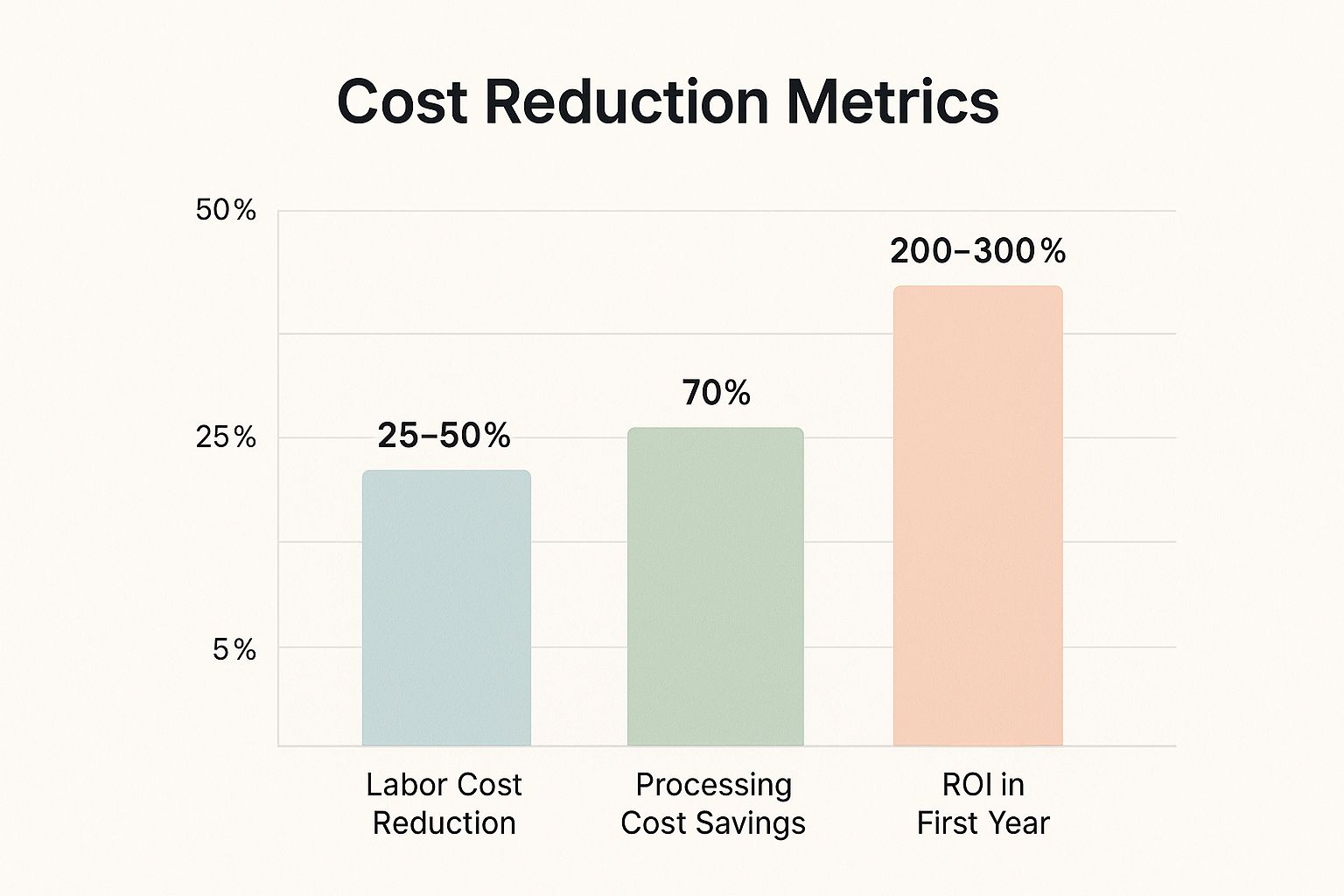Unlocking Your Business Potential: The Power of Automated Workflows
In today's competitive business environment, working smarter isn't just an advantage; it's essential for survival and growth. Repetitive, manual tasks consistently consume valuable time, introduce costly errors, and divert skilled employees from high-impact work. The most effective solution is strategic automation. By implementing automated systems, you can transform your operations from the ground up, streamlining processes to unlock new levels of efficiency and scale. The workflow automation benefits are substantial, ranging from direct cost savings to a more engaged and productive workforce.
This guide moves beyond theory to provide a detailed breakdown of the seven most significant advantages businesses are realizing from automation. We will explore how these benefits translate into tangible results, offering actionable insights and real-world scenarios tailored for various trades. A prime example of this transformative power is seen in how HR process automation streamlines complex administrative tasks, freeing up valuable human resources. From improving accuracy in client billing to accelerating project timelines, you will learn exactly how to apply these concepts to gain a critical edge. Let’s dive into the specific ways automation can redefine your business potential.
1. Increased Operational Efficiency
At its core, one of the most significant workflow automation benefits is the dramatic boost in operational efficiency. This means systematically replacing time-consuming, repetitive manual tasks with automated systems that execute them faster and more consistently. For tradespeople, this translates directly into more time spent on billable work and less on administrative burdens like data entry, scheduling, or generating reports. By streamlining these essential but non-billable activities, your business can handle more jobs without increasing headcount, directly enhancing productivity and capacity.

The principle isn't new; it’s an evolution of concepts popularized by pioneers like Toyota with its lean manufacturing and Amazon with its revolutionary warehouse automation. Today, these ideas are accessible to businesses of all sizes. For example, a plumbing company can automate its lead processing using tools like Zapier, instantly converting a website form submission into a new customer profile, a work order, and a notification to the on-call technician. This reduces lead response time from hours to mere minutes, increasing the likelihood of winning the job.
How to Implement This for Your Trade
To harness this benefit, you need a clear strategy. Start by identifying the biggest time sinks in your daily operations. Where do your technicians and office staff spend most of their non-billable time?
- Map Your Processes: Begin by visually mapping your current workflows from a new lead to a paid invoice. Pinpoint every manual step, like transcribing job notes or manually sending follow-up emails.
- Prioritize High-Impact Tasks: Focus first on high-frequency, low-complexity tasks. Automating appointment reminders or generating daily work summaries provides a quick win and immediate time savings.
- Measure Before and After: Establish baseline metrics before you automate. How long does it take to process a new work order manually? Track this, implement the automation, and then measure the improvement to quantify your return on investment.
- Test Thoroughly: Before a full rollout, test your new automated workflow in a controlled environment. Ensure it functions correctly and doesn't create new bottlenecks. This prevents disruptions to your daily operations.
By methodically identifying and automating these tasks, you free up valuable hours. Furthermore, adopting modern IT infrastructure is key. Exploring how Cloud Services can help save your business time provides another layer of efficiency, allowing your team to access critical information and software from anywhere, which is crucial for field technicians. This combination of targeted workflow automation and cloud-based tools creates a powerfully efficient operational model.
2. Enhanced Accuracy and Reduced Human Error
Beyond just saving time, another of the core workflow automation benefits is the significant reduction in human error. Manual data entry, transcribing notes, and calculating quotes are all susceptible to mistakes, no matter how careful a person is. These small errors can snowball into major problems, such as incorrect part orders, misquoted job costs, or missed appointments, all of which damage your reputation and bottom line. Automation standardizes these processes, ensuring tasks are performed with near-perfect accuracy every time.

This principle is heavily influenced by quality control methodologies like Six Sigma, famously used by manufacturing giants like General Electric to minimize defects. For a trades business, this might mean an HVAC company using software that automatically pulls parts and pricing information from a digital catalog to generate a customer quote. This eliminates the risk of a technician accidentally typing the wrong part number or miscalculating the total cost. By removing the variable of human error from routine tasks, you deliver a more consistent and reliable service, which directly boosts customer satisfaction and trust.
How to Implement This for Your Trade
Achieving higher accuracy requires a systematic approach to identifying and automating error-prone tasks. Start by asking where mistakes most frequently occur in your workflow.
- Implement Validation Checkpoints: Build rules into your automated systems. For example, if a work order is being created, the system can automatically check that a valid customer address has been entered before it proceeds. This prevents technicians from being dispatched to non-existent locations.
- Audit Automated Outputs: Don't just "set it and forget it." Periodically review the outputs of your automated workflows, such as generated invoices or inventory reports, to ensure they remain accurate. This helps catch any issues before they impact a customer.
- Establish Exception Handling: Plan for the unexpected. Create a clear, documented procedure for what happens when an automated process encounters an edge case it can't handle. For example, if an automated invoicing system fails, it should immediately flag the invoice for manual review by an office administrator.
- Document Your Business Rules: Keep a detailed record of the logic behind your automations. For instance, document precisely how your system calculates labor costs or applies discounts. This makes it easier to troubleshoot and update the system as your business evolves.
By focusing on accuracy, you not only prevent costly mistakes but also build a more professional and dependable operation. The precision that automation brings is a key differentiator in a competitive market, solidifying your reputation as a reliable and high-quality service provider.
3. Significant Cost Reduction
Beyond improving efficiency, one of the most compelling workflow automation benefits is a direct and substantial reduction in operational costs. This is achieved by automating labor-intensive processes, which cuts down on payroll hours for repetitive tasks, and by minimizing costly human errors that often lead to rework, wasted materials, or even compliance fines. For a trades business, this means lower overhead on everything from invoicing to inventory management, allowing you to reallocate those savings toward growth, new equipment, or better profit margins.
The bar chart below highlights key financial metrics that businesses often experience after implementing automation, showing a significant impact on labor costs, processing expenses, and overall return on investment.

The data clearly illustrates that automation's financial impact is multifaceted, with a typical first-year ROI reaching between 200-300%, making it a financially sound strategic investment.
This principle has been proven at scale by industry giants and consulting firms like McKinsey & Company and IBM. For instance, Deutsche Bank reportedly saved over $1 billion annually through robotic process automation (RPA), and American Express slashed its expense report processing costs by a staggering 70%. While your HVAC or electrical business may not operate on that scale, the principles are identical. Automating your invoicing process can reduce the time spent chasing payments, and an automated inventory system can prevent over-ordering or running out of critical parts, both of which directly impact your bottom line.
How to Implement This for Your Trade
To realize these cost savings, a strategic approach is necessary. You must identify where your money is truly going and which automated solutions will provide the quickest and most significant return.
- Calculate Total Cost of Ownership: Before investing, look beyond the initial software price. Factor in implementation fees, employee training time, and any ongoing maintenance or subscription costs to get a true picture of the investment.
- Focus on High-Volume Processes: The biggest cost savings come from automating tasks that are done frequently. Target high-volume, labor-intensive activities like creating quotes, processing payments, or scheduling preventative maintenance for maximum financial impact.
- Consider Cloud-Based Solutions: Modern cloud-based automation tools often have lower upfront infrastructure costs than on-premise systems. They eliminate the need for expensive servers and are easier to scale as your business grows.
- Implement Gradually: You don't need to automate everything at once. Start with one process, like automated appointment reminders, to validate the ROI. This phased approach allows you to spread out costs and build momentum.
By carefully analyzing your expenses and targeting the most impactful areas, you can leverage automation to significantly reduce your operational costs. This creates a more resilient and profitable business model, which is a crucial advantage in any competitive trade industry.
4. Improved Employee Satisfaction and Productivity
Beyond process improvements, one of the most impactful workflow automation benefits is the significant boost in employee satisfaction and productivity. Automation systematically removes mundane, repetitive tasks from your team's daily workload, such as manual data entry, chasing down paperwork, or retyping information between different systems. This frees up your technicians and office staff to concentrate on higher-value work that requires their expertise, problem-solving skills, and customer interaction abilities. The result is a more engaged workforce that feels valued for their skills, not just their ability to complete tedious chores.
This concept has been championed by tech leaders like Google and Atlassian, who recognize that happy, empowered employees are more productive. For a trade business, this is just as critical. Imagine an experienced HVAC technician who can spend their time diagnosing a complex system failure instead of filling out duplicate forms. Or an office manager who can focus on strategic scheduling and customer relationships instead of manually sending out hundreds of invoice reminders. This shift doesn't just improve morale; it directly enhances productivity by allowing your best people to do their best work.
How to Implement This for Your Trade
Boosting morale through automation requires a thoughtful, employee-centric approach. The goal is to position automation as a tool for empowerment, not replacement.
- Communicate the "Why": Before implementing new tools, clearly explain to your team how automation will benefit them directly. Frame it as a way to eliminate their most frustrating tasks and create opportunities for professional growth and skill development.
- Involve Employees in the Process: Ask your team to identify the most tedious parts of their jobs. Involving them in selecting which workflows to automate gives them a sense of ownership and ensures you're solving real-world pain points, not just perceived ones.
- Provide Comprehensive Training: Invest in proper training for any new software or automated process. When employees feel confident using new tools, they are more likely to embrace them. Ensure they understand how the new workflow connects to the bigger picture.
- Create New Opportunities: As automation frees up time, create clear paths for career advancement. A technician might now have time to train an apprentice, or an administrator could take on a customer success management role, leveraging the skills that automation can't replicate.
By focusing on your team's experience, you turn a technical upgrade into a cultural one. This not only makes your business more efficient but also a better place to work, helping you attract and retain top talent in a competitive market.
5. Enhanced Scalability and Business Agility
Another of the key workflow automation benefits is the ability to grow your business without hitting a wall. Enhanced scalability and business agility mean your operations can handle a surge in demand just as easily as a slow week, without needing a proportional increase in staff or administrative overhead. For a growing trade business, this is crucial. It allows you to take on more jobs, expand into new territories, or handle seasonal peaks efficiently, ensuring your back-office processes don’t become a bottleneck to your growth.

This concept was pioneered and perfected by tech giants like Amazon Web Services, which built systems that could elastically scale to meet global demand, and Airbnb, which created a marketplace that could onboard hosts and guests automatically worldwide. Today, this power is accessible to any trade. Imagine your HVAC company runs a successful summer promotion. An automated system can handle the flood of new service requests, schedule dozens of new appointments, and generate the corresponding work orders without your office manager working overtime. This agility allows you to seize market opportunities quickly and effectively.
How to Implement This for Your Trade
To build a scalable business, you must design your workflows for growth from day one. It’s not about just handling today's workload; it's about preparing for tomorrow's.
- Design for Growth: When setting up an automation, consider what would happen if you had to process ten times the volume. Would the workflow break? Choose tools and design processes that can handle significant increases in tasks without manual intervention.
- Leverage Cloud Platforms: Use cloud-based automation software and field service management (FSM) systems. These platforms are built for elastic scaling, meaning they automatically allocate more resources during peak times and scale back during lulls, so you only pay for what you use.
- Monitor Performance: Implement systems to track your workflow performance, especially during high-demand periods. Monitor metrics like job processing time, scheduling accuracy, and system response speed to identify potential bottlenecks before they impact your customers.
- Test Scaling Scenarios: Before your busy season hits, run stress tests on your automated systems. Simulate a sudden spike in service requests to ensure your workflows for dispatching, invoicing, and customer communication can handle the pressure without failing. This proactive approach prevents system crashes when you can least afford them.
6. Better Compliance and Audit Trail Management
Navigating the complex landscape of regulations, safety standards, and client requirements is a major challenge for any trade business. One of the most powerful workflow automation benefits is its ability to build better compliance and audit trail management directly into your daily operations. Automation creates a systematic, unchangeable record of every action taken, providing a detailed digital log that proves procedures were followed correctly. This is crucial for demonstrating adherence to safety protocols, industry standards, and legal requirements.
The need for meticulous record-keeping was heavily spotlighted in highly regulated sectors like finance after the 2008 crisis, where firms like JPMorgan Chase began using automated systems to monitor activities for compliance. Similarly, consulting giants like Deloitte and PwC pioneered regulatory technology solutions to help clients manage complex rules. For trades, this concept is just as relevant. Imagine an HVAC company needing to prove refrigerant usage and disposal was handled according to EPA regulations. An automated workflow that logs every step, from canister check-out to final disposal documentation, creates an unbreakable audit trail, protecting the business from fines and liability.
How to Implement This for Your Trade
Strengthening your compliance framework with automation requires a structured approach that ties your processes directly to regulatory mandates.
- Map Regulatory Requirements: Start by listing all relevant industry regulations (e.g., OSHA safety checks, EPA rules, local building codes). Map each requirement to a specific step in your job workflow. For instance, a pre-work safety checklist must be completed and logged before a technician can start a job.
- Implement Automated Alerts: Configure your system to send instant notifications for compliance deviations. If a required safety form isn't submitted or a critical part inspection is missed, an alert can be sent to a supervisor immediately, allowing for real-time correction before it becomes a bigger issue.
- Automate Documentation: Ensure that every completed compliance task, such as a safety briefing or a material handling form, automatically generates a timestamped digital record. This record should be stored securely and linked to the corresponding job or customer, making it easy to retrieve during an audit.
- Schedule Regular Reviews: Regulations change. Set up automated reminders for your team to periodically review and update the compliance rules programmed into your workflows. This ensures your automated processes never become outdated.
By embedding these checks and balances into your automated systems, you transform compliance from a manual, error-prone task into a consistent and reliable part of your business. This not only mitigates risk but also enhances your professional reputation, showing clients and regulators that you operate with the highest standards of accountability.
7. Faster Decision-Making Through Real-Time Data
In a competitive market, the speed and quality of your decisions can make or break your business. A core workflow automation benefit is the ability to make faster, more informed decisions fueled by real-time data. Instead of waiting for weekly or monthly reports, automated systems continuously collect, process, and present critical business information as it happens. This empowers trade business owners and managers to react instantly to emerging opportunities or potential problems, moving from reactive problem-solving to proactive strategy.
This concept is famously used by giants like Tesla, where real-time production data from the factory floor allows engineers to make immediate adjustments to maintain quality and efficiency. For trades, this principle is just as impactful. Imagine an HVAC company's dashboard automatically showing which technician is closest to an emergency job or highlighting which service contracts are most profitable in real-time. This eliminates guesswork and ensures resources are allocated for maximum impact, a key advantage of leveraging workflow automation benefits.
How to Implement This for Your Trade
To leverage real-time data, you must first identify what information is most critical for your daily and strategic decisions. The goal is to transform raw data into actionable insights that your team can use on the fly.
- Define Key Performance Indicators (KPIs): Identify the metrics that matter most to your business. This could include technician travel time, first-time fix rate, average invoice value, or customer satisfaction scores. Focus on a handful of vital KPIs to avoid information overload.
- Design Actionable Dashboards: Use a field service management tool or data visualization software like Tableau to create dashboards that display your KPIs clearly. The dashboard should immediately answer your most important questions, such as "Are we on track to meet our weekly revenue goal?"
- Create Automated Alerts: Set up automated notifications for critical events. For example, create an alert if a technician's job runs 30 minutes over the estimated time or if a key piece of inventory drops below a certain threshold. This allows you to address issues before they escalate.
- Ensure Data Quality: Your decisions are only as good as your data. Implement automated validation rules within your job management software to ensure information, like part numbers or customer addresses, is entered correctly from the start.
By creating a live feedback loop, you empower your entire organization to make smarter choices. Managers can optimize schedules based on live traffic and job status, while technicians in the field can access up-to-date customer history to provide better service. This agility is a powerful competitive advantage that stems directly from effective workflow automation.
Workflow Automation Benefits Comparison
From Theory to Action: Implementing Your Automation Strategy
We've explored the profound and multifaceted workflow automation benefits, moving from abstract concepts to concrete realities. You’ve seen how automation is not just a tool for large corporations but a critical asset for trade businesses aiming for peak performance. The advantages are clear: from slashing the time spent on manual data entry to eliminating costly human errors, the impact is both immediate and far-reaching. By automating routine tasks, you empower your technicians to focus on their specialized skills, boost team morale, and create a more productive, satisfying work environment.
More than just saving time and money, you've learned how automation builds a more resilient and agile business. It enhances your ability to scale operations without a proportional increase in administrative overhead. It fortifies your compliance measures with flawless audit trails and accelerates decision-making with real-time data insights. These aren't just minor improvements; they represent a fundamental shift in how your business operates, positioning you to thrive in a competitive landscape. The cumulative effect of these benefits creates a powerful competitive advantage, enabling faster service, more accurate billing, and superior customer satisfaction.
Your First Step: The Power of Incremental Implementation
The path to harnessing these workflow automation benefits doesn't require a massive, disruptive overhaul of your entire operation. The most successful transformations begin with a focused, strategic first step. The key is to identify and target a single process that is high-impact yet low in implementation complexity. This "quick win" demonstrates tangible value, builds confidence within your team, and creates momentum for more extensive automation projects.
Consider the daily pain points that slow your team down. Is it the process of transcribing handwritten field notes? Or perhaps the tedious task of manually creating work orders from customer emails? These are perfect candidates for your initial automation effort.
A Practical Starting Point for Trade Professionals
Here is a simple, actionable plan to get started:
- Identify a Key Bottleneck: Pinpoint one repetitive, manual task that consumes significant time or is a common source of errors. A great example is collecting service notes, photos, and asset information from technicians in the field.
- Choose the Right Tool: Select a solution designed for simplicity and seamless integration into your existing workflows. Avoid tools that require extensive training or force your field team to adopt entirely new, complex applications. The goal is to reduce friction, not create more of it.
- Implement and Measure: Roll out the new automated process with a small group or for a specific type of job. Track the time saved, the reduction in errors, or the improvement in data quality. For instance, measure the time from job completion to invoice submission before and after automation.
- Gather Feedback and Scale: Use the positive results and feedback from your initial project to justify expanding automation to other areas, such as parts ordering, customer follow-ups, or compliance reporting.
Mastering automation is no longer a luxury; it is an essential component of modern business strategy. By starting small and proving the concept, you can methodically transform your operations from a series of manual, disjointed tasks into a streamlined, efficient, and intelligent system. This journey begins not with a giant leap, but with a single, smart, automated step.
Ready to see how simple the first step can be? Discover how Nora uses the familiarity of WhatsApp to effortlessly automate field data collection, turning technician chats into structured, actionable insights in your system. Experience the most powerful workflow automation benefits with zero disruption to your team's routine.



